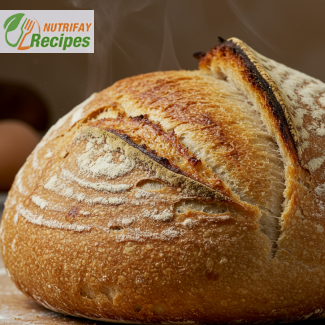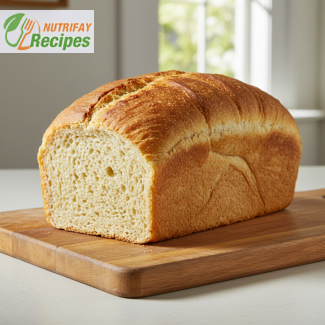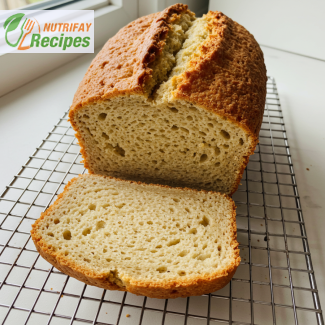The Perfect Homemade Bread Recipe for Beginners
There’s nothing quite like the warm, comforting aroma of freshly baked bread filling your kitchen. This easy homemade bread recipe is perfect for beginners, requiring just a handful of ingredients and simple steps to create a soft, fluffy loaf with a golden crust. Whether you’re new to baking or looking for a foolproof method, this guide will walk you through the process, ensuring you achieve bakery-quality results every time.
A Simple and Rewarding Bread Baking Experience
Making bread at home may seem intimidating, but with this step-by-step guide, you’ll discover just how easy and rewarding it can be. With a few pantry staples, minimal kneading, and a bit of patience, you’ll create a perfectly risen loaf that’s soft on the inside and slightly crisp on the outside. This recipe is designed for beginners, ensuring consistent success even if it's your first time baking bread.
By following this method, you’ll learn the key techniques of bread-making, from activating the yeast to shaping and baking your dough. The result? A delicious, homemade loaf that’s free from preservatives and artificial ingredients, making it a healthier and tastier alternative to store-bought bread.
Why You’ll Love This Homemade Bread Recipe
- Beginner-Friendly – No prior baking experience is needed; this recipe is simple and straightforward.
- Basic Ingredients – Made with flour, water, yeast, salt, and a touch of sugar – all commonly found in most kitchens.
- Soft and Fluffy Texture – The perfect balance of chewiness and tenderness in every bite.
- Versatile and Customizable – Can be adapted with different flours, herbs, or seeds for a unique twist.
- No Special Equipment Required – You don’t need a bread machine or a stand mixer; just your hands and a mixing bowl.
- Satisfying and Cost-Effective – Baking your own bread is cheaper than buying artisanal loaves from the store.
The Secret to Perfect Homemade Bread Every Time
One of the biggest challenges in bread-making is achieving the right texture. This recipe simplifies the process, ensuring a light, airy crumb with a crust that has just the right amount of crispness. The secret lies in:
- Proper yeast activation – Allowing the yeast to fully dissolve in warm water with a touch of sugar ensures a good rise.
- Gentle kneading – Just enough to develop gluten without overworking the dough.
- Adequate rising time – Letting the dough rest until it doubles in size creates an airy, soft loaf.
- Perfect baking temperature – A preheated oven ensures even baking and a beautifully golden crust.
The Joy of Freshly Baked Bread at Home
Nothing beats the first slice of warm, homemade bread spread with butter or drizzled with honey. Whether you enjoy it as toast in the morning, as a side for soups, or as the base for your favorite sandwiches, this bread is irresistibly soft, fresh, and full of flavor.
If you've never baked bread before, now is the perfect time to start. With this simple recipe, you’ll gain confidence in your baking skills and discover just how easy it is to create something delicious from scratch.
Ready to Bake Your First Loaf?
With just a little time and effort, you can enjoy homemade bread that tastes better than anything store-bought. Follow the easy steps in this recipe, and soon, you’ll be pulling a golden, fluffy loaf from your oven. Try it today and experience the joy of making fresh, delicious bread at home!
- Activate the yeast
In a small bowl, mix warm water and sugar. Sprinkle the yeast over the surface, stir gently, and let sit for 5–10 minutes until foamy. This indicates that the yeast is active. - Mix the dough
In a large mixing bowl, combine the flour and salt. Make a well in the center and pour in the yeast mixture along with the olive oil. Stir with a wooden spoon or your hands until a shaggy dough forms. - Knead the dough
Transfer the dough onto a lightly floured surface and knead for about 8–10 minutes until it becomes smooth and elastic. If the dough is too sticky, sprinkle a little extra flour, but avoid adding too much. - First rise
Place the dough in a lightly greased bowl, cover with a damp towel or plastic wrap, and let it rise in a warm place for 60–90 minutes, or until doubled in size. - Shape the loaf
Once risen, punch down the dough to release excess air. Transfer it to a floured surface, shape it into a loaf, and place it in a greased or parchment-lined bread pan (22x12 cm / 9x5 inches). - Second rise
Cover the loaf and let it rise again for 30–40 minutes, until slightly puffed. - Bake the bread
Preheat the oven to 200°C (400°F). Place the bread in the oven and bake for 25–30 minutes, or until the top is golden brown and the loaf sounds hollow when tapped. - Cool before slicing
Remove the bread from the pan and transfer it to a wire rack. Let it cool completely before slicing to ensure the best texture.
How to Perfect Your Homemade Bread Recipe: Expert Tips and Ingredient Variations
Making homemade bread is an art that combines technique, patience, and high-quality ingredients. While the basic recipe provides a delicious, soft, and airy loaf, small adjustments can create unique flavors, textures, and even health benefits. Whether you’re looking to make your bread softer, crunchier, more nutritious, or gluten-free, these expert tips will help you master the art of baking.
Understanding the Role of Each Ingredient
Each ingredient in this easy homemade bread recipe plays a crucial role in determining the texture, rise, and flavor. Understanding their functions will allow you to make adjustments based on your preferences.
Flour: The Foundation of Your Bread
- All-purpose flour creates a soft and light crumb, making it perfect for beginners.
- Bread flour has a higher protein content, resulting in a chewier, stronger structure.
- Whole wheat flour adds a nutty, rich flavor and increases fiber content but can make the loaf denser.
- Gluten-free flour blends allow those with intolerances to enjoy fresh bread, though they often require binders like xanthan gum for structure.
Yeast: The Key to a Perfect Rise
- Active dry yeast needs to be dissolved in warm water before use, ensuring activation.
- Instant yeast can be added directly to the flour, making it more convenient.
- Fresh yeast provides a richer flavor but has a shorter shelf life.
Water: The Ingredient That Affects Crumb Texture
- More water in the dough creates a lighter, airier loaf with larger holes (ideal for rustic bread).
- Less water makes a denser loaf, which is easier to slice and toast.
- Milk instead of water enhances the softness and gives a richer flavor.
Sugar: More Than Just Sweetness
- Sugar, honey, or maple syrup feeds the yeast, helping the dough rise faster.
- No sugar results in slower fermentation but allows for a more complex, slightly tangy flavor.
Salt: The Secret to Flavor Balance
- Salt controls yeast activity, preventing the dough from rising too quickly.
- Reducing salt makes the bread rise faster, but the flavor may become flat.
- Sea salt or Himalayan salt can enhance the natural taste of flour.
Fat: The Softness Factor
- Olive oil results in a softer, slightly chewy crumb.
- Butter adds richness and a subtle buttery taste.
- No fat makes a crustier, firmer bread, often found in rustic loaves.
Adjusting the Texture and Flavor
Making small ingredient swaps or technique changes can help you achieve the exact texture, flavor, and crust you prefer.
How to Make Bread Softer
- Use milk instead of water for a richer, softer loaf.
- Add a little more fat (butter or olive oil) for a more tender crumb.
- Increase kneading time to develop gluten more evenly.
How to Make Bread Chewier
- Use bread flour instead of all-purpose flour for higher gluten development.
- Let the dough rise longer for a better gluten network.
- Bake at a higher temperature to get a firmer crust while keeping the inside soft.
How to Make Bread More Flavorful
- Use a slow fermentation process (letting it rise overnight in the fridge) to develop deeper, complex flavors.
- Add a bit of whole wheat or rye flour for a rich, earthy taste.
- Mix in herbs, garlic, or cheese for a delicious twist.
How to Get a Crispier Crust
- Bake with steam by placing a pan of hot water in the oven during baking.
- Use a preheated baking stone to distribute heat evenly.
- Brush the dough with a little water or an egg wash before baking.
Substitutions for Dietary Needs
Making Bread Gluten-Free
- Use a gluten-free flour blend and add 1 tsp of xanthan gum for structure.
- Increase hydration slightly, as gluten-free flours absorb more moisture.
- Allow for a longer rise time to compensate for the lack of gluten.
Making Bread Dairy-Free
- Replace milk with water or almond milk for a lighter, dairy-free alternative.
- Use olive oil or coconut oil instead of butter to maintain softness.
Making Bread Healthier
- Replace half of the white flour with whole wheat flour for added fiber.
- Use honey or maple syrup instead of sugar for a natural sweetness.
- Add chia seeds, flaxseeds, or sunflower seeds for an extra boost of nutrients.
Common Bread-Baking Mistakes and How to Fix Them
Even with the best recipe, mistakes can happen. Here’s how to avoid the most common problems when baking homemade bread.
Bread Didn't Rise Properly
- Check that the yeast is fresh and active. Expired yeast won’t work.
- Ensure the water isn’t too hot (kills yeast) or too cold (doesn’t activate it).
- Let the dough rise in a warm, draft-free place for best results.
Bread Turned Out Too Dense
- Not kneading enough can result in less gluten formation, leading to a heavy texture.
- Using too much flour can make the dough too dry—add just enough to keep it slightly sticky.
- Short rising times can lead to underdeveloped dough—let it rise fully.
Bread Has a Thick or Tough Crust
- A thick crust is often due to baking too long or at too high a temperature. Reduce the temperature slightly.
- Using milk or butter in the dough will make the crust softer.
The Joy of Customizing Your Homemade Bread
Experimenting with different flours, liquids, and rising times can help you discover the perfect bread for your taste. Whether you prefer a classic white sandwich loaf, a hearty whole wheat bread, or a chewy sourdough, small changes can dramatically alter the texture and flavor of your homemade bread.
Try out these adjustments and discover how simple tweaks can transform your baking experience. Once you’ve mastered the basics, don’t hesitate to get creative—homemade bread is all about making it your own!
This recipe contains gluten due to the wheat flour. If you have a gluten intolerance, substitute with gluten-free all-purpose flour and add 1 tsp of xanthan gum for better structure.
Alternative Ingredients for Allergies
- Gluten-free: Use a gluten-free flour blend.
- Dairy-free: The recipe is naturally dairy-free, but if using butter, replace it with olive oil or coconut oil.
- Low-sodium: Reduce the salt to 5 g (1 tsp) or use a salt substitute.
- Vitamin B1 (Thiamine): 0.2 mg – Supports energy production.
- Vitamin B3 (Niacin): 2.5 mg – Essential for metabolism.
- Iron: 1.5 mg – Important for oxygen transport.
- Magnesium: 10 mg – Helps muscle and nerve function.
- Zinc: 0.6 mg – Supports immune function.
- Ferulic acid (found in wheat flour): Supports cardiovascular health.
- Selenium: 7 mcg – Helps reduce oxidative stress in the body.
- Phenolic compounds: Assist in reducing inflammation.
Enjoy your homemade bread fresh or toasted with your favorite toppings!







